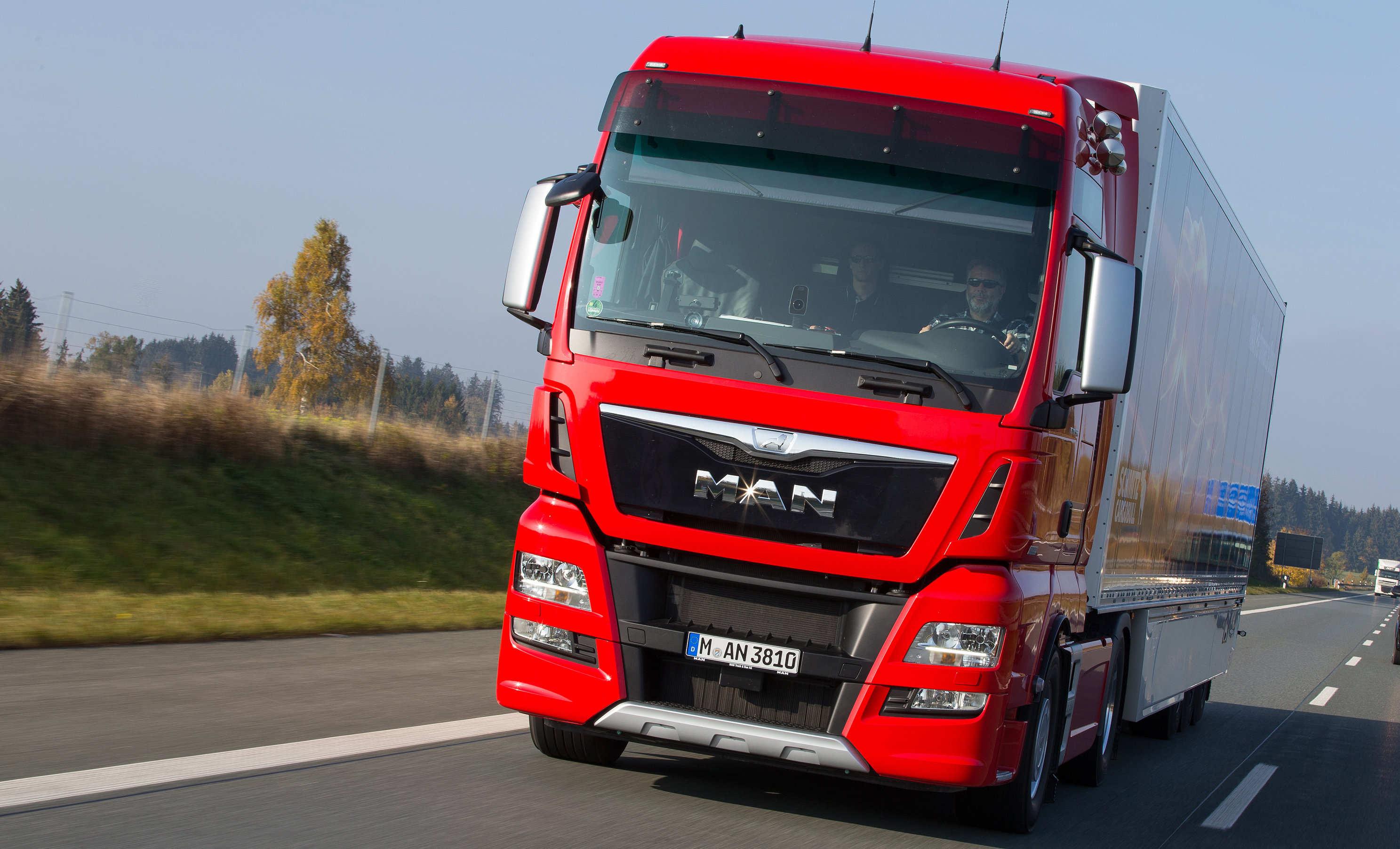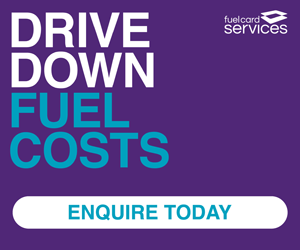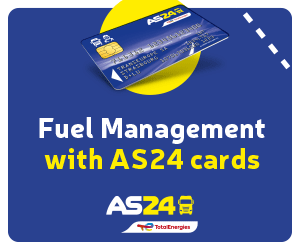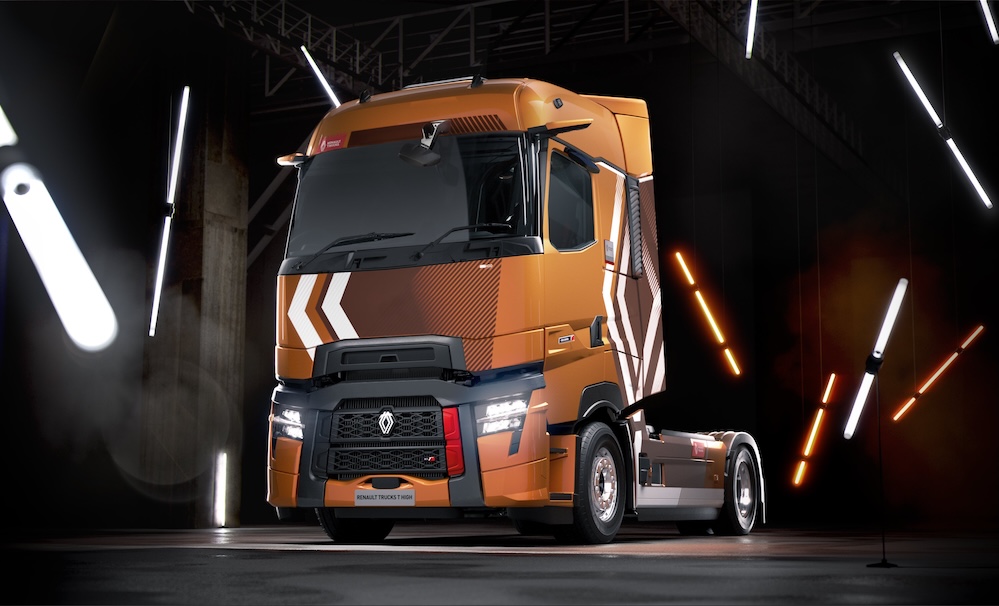As part of the 2016 model year, MAN is offering its customers several upgraded equipment features in the TGX D38. The top model is tailor-made for extraordinarily efficient driving at low speeds. For its flagship model, MAN is placing a consistent focus on the total cost of operation (TCO): the TGX D38 driveline has undergone rigorous development and, since summer 2015, has featured a new generation of gearboxes in the form of the MAN TipMatic TX, along with extended convenience functions. In the new model generation, the EfficientCruise assistant uses even more functions to save fuel.
EfficientCruise and EfficientRoll
Since the EfficientCruise GPS cruise control system was launched on the market, the system has been impressing customers and specialist media with its driver-orientated adjustment, detailed route preview and fuel savings of around six percent. MAN has already sold approximately 9000 vehicles with EfficientCruise.
MAN has further improved the anticipatory speed adjustment of the EfficientCruise system. In the 2016 model generation, the system also controls the EfficientRoll coasting mode, thereby combining the advantages of both systems. In conjunction with EfficientRoll, the new EfficientCruise always activates the coasting function if this will actually save fuel. To do this, the system uses stored 3D map information of the route.
Furthermore, EfficientCruise actively proactively intervenes in the gear selection and shifts down to the most appropriate gear in good time before inclines so that there is no interruption to tractive force when going uphill. For short inclines, the vehicle completely prevents downshifts if possible. To save more fuel, the vehicle shifts up in good time once the hill has been climbed.
The system is based on a route preview that is calculated using the 3D map information saved on the on-board computer and the vehicle’s location based on satellite signals (GPS). This means the vehicle automatically drives in a forward-looking manner – in other words, it builds up momentum before the incline and then reduces speed to roll over the brow of the hill. Using EfficientCruise in long-haul or distribution transport can lower a vehicle’s fuel consumption by up to six per cent without incurring any time loss along the way. The assistant supports the driver on long distances by taking over the challenging task of always knowing when it is best to accelerate.
The assistant’s tried and trusted operation will not change with the 2016 generation: based on the desired speed chosen by the driver and the speed tolerance that can be set to four levels, EfficientCruise calculates the suitable speed for consumption-optimised driving on uphill and downhill gradients and adapts the vehicle speed accordingly. The driver can adjust the tolerance level for deviations from the set speed at any time to suit the driving scenario. Four field-tested levels make it easier for the driver to choose the right setting. When switching on, level 3 is selected automatically, which corresponds to a spread of +/- 7 km/h. Level 4 allows for even greater leeway both upwards and downwards for low traffic volumes; levels 1 and 2 are good driving options when traffic is heavier.
Optimised driveline with new convenience functions
The MAN top model uncompromisingly combines driving dynamics and fuel efficiency. The two-stage-turbocharging makes full torque available for the engine at 930 rpm. The maximum torques of 2500 Nm (520 hp), 2700 Nm (560 hp) and 3000 Nm (640 hp heavy duty) are available in all gear speeds.
The TGX D38 is therefore tailor-made for extraordinarily efficient long-haul driving at low speeds. Customers can select fuel-saving high drive ratios without sacrificing drive comfort or losing out on flexibility. To do this, MAN has carried out consistent development of the TGX D38 driveline and integrated the MAN TipMatic TX gearbox generation with new convenience functions in the vehicle.
The direct-drive version of the TipMatic TX gearbox is designed for the high torque of 2500 to 2700 Nm produced by the D38 engines. This means MAN is able to offer particularly efficient driveline configurations for all performance levels for long-haul driving and for traction vehicles with a gross train weight of up to 70 tonnes.
The MAN TipMatic TX has a particularly high spread across the 12 gears (16.69–1). A low transmission ratio for the “highest” gear allows it to be combined with axle transmission optimised for long-haul transport, thus saving fuel when driving at very low speeds. At the same time, a high transmission ratio for the “lowest” gear allows for slow driving and convenient manoeuvring, despite the low rear axle transmission. This reduces the wear on the clutch.
For customers buying the top model, they can choose from a wide range of convenience functions for the driveline. These functions ensure the TGX D38 is particularly efficient at high capacity.
Gradient sensor and Active Damping: thanks to the integrated gradient sensor, the TGX D38 takes the current topography into account when selecting a gear. The driveline always finds the right gear for moving off – whether driving uphill, with an empty vehicle or with full loads. The high transmission-ratio spread and a newly developed clutch actuator help to achieve excellent moving-off and manoeuvring behaviour. The new “Active Driveline Damping” function helps the driver move off smoothly, even under difficult driving conditions, while an anti-cyclic, pulsed clutch actuator counteracts vibrations in the driveline.
Manoeuvring feature and rocking-free function: MAN has optimised the manoeuvring feature in the new generation: the interaction between the accelerator position and clutch controls has been designed to function even more smoothly, so that the driver can manoeuvre more accurately at the loading ramp or when picking up swap bodies.
The MAN TGX D38 also offers a rocking-free function. This makes it easier for vehicles to move off when stuck on snow-covered roads or on construction sites, for example. If the function is activated, the clutch opens very quickly, so long as the driver has lifted off the accelerator. If the accelerator is pressed again the clutch closes, allowing the driver to carefully rock the vehicle free. A suitable gear is selected automatically here in order to reduce the torque to the drive wheels and thus avoid wheel spin.
Speed shifting: thanks to the engine, clutch and gearbox control being specially coordinated, the MAN TipMatic TX shifts between the three highest gears – 10th, 11th and 12th – more quickly. This means, for example, that the gearbox can shift down more quickly when going uphill and the torque for tractive force interruption is shortened. This in turn means that greater momentum is maintained, saving the vehicle’s fuel.
EfficientRoll: the EfficientRoll gearbox function is designed for motorway and country road stretches that run gently downhill. Even on almost flat stretches, fuel can be saved as the vehicle automatically shifts to neutral and coasts, without the vehicle’s speed being reduced by engine braking. The new generation EfficientCruise assistant automatically activates EfficientRoll and always when fuel can be saved.
Idle Speed Driving: the Idle Speed Driving function uses the high torque of the 15.2-litre engine at low speeds, providing greater comfort when driving slowly and allowing for greater fuel-savings. This is particularly practical in stop-go traffic or when coasting up to a roundabout. In such situations, the vehicle will continue to move forward with the engine at idling speed and the clutch closed, as long as the driver does not brake.
New generation safety systems with sensor fusion
An emergency braking assistant is fitted as standard in the MAN TGX D38. This includes all vehicle types affected by carriage recertification requirements from November 2015, and therefore the vast majority of MAN trucks. The EBA emergency braking assistant fitted by MAN since July 2015 already exceeds the stricter legal requirements for Level 2 which come into force in November 2018 for newly registered vehicles. This means that customers are purchasing a high-value and future-proof system.
MAN’s new generation of the EBA emergency braking system combines information from the radar sensor in the front end and from the windscreen-mounted camera. This sensor fusion allows the system to make trustworthy interpretations of situations on the road. Vehicles in front and stationary obstructions can be identified faster and with greater certitude. The system thus gains time to initiate emergency braking earlier if so required. In an emergency the vehicle can thus shed more speed and come to a halt some valuable metres sooner.
The EBA reacts to a detected emergency braking object and to the absence of driver response (either a change of lane or braking) with a number of measures spread over time. The driver is warned first by a penetrating warning tone and a message on the display. At this moment, the brake lines are already pre-filled so as to shorten the response. At the same time, the brake lights are activated, in order to give timely warning to vehicles behind.
In addition, the MAN EBA system cuts the engine torque as early as the warning phase. This represents a further noticeable warning effect for a driver who may not be paying attention. Should the driver not react, the brakes will be applied automatically as a warning (warning braking). If the risk of collision is still likely and the driver is failing to react, the EBA initiates emergency braking which under ideal conditions prevents driving into the obstacle, even from full speed at 80 km/h.
The interaction of the radar and camera significantly reduces the risk of unjustified warnings since two technologies can be used for object recognition. MAN thus achieves its aim of bothering the driver as little as possible with warning signals.
Emergency Stop Signal (ESS)
In the event of emergency braking, the Emergency Stop Signal (ESS) activates not only the brake lights but also the hazard warning lights which flash rapidly (emergency braking flashing) and thus signal an emergency situation to vehicles behind. Trials have demonstrated that timely warning helps prevent rear-end shunts.
The new Lane Guard System (LGS) and ACC
The new Lane Guard System (LGS) uses the latest camera technology. This makes for greater accuracy in lane detection and a minimum of unjustified warnings. At speeds above 60 km/h the LGS monitors the vehicle’s position with respect to the lane and warns the driver should he accidentally cross the lane markings.
Additional functions improve the driver’s comfort. The new system detects autonomously when lane conditions change: a reliable warning is only possible when right-hand and left-hand lane markings are present and the lane exceeds a minimum width. The new LGS also takes into account the fact that many drivers for the sake of safety like to drive on the outside of the lane – that is, at the right edge in countries which drive on the right – and for this side of the lane gives a warning later. The system also adjusts automatically to whether the country drives on the left or on the right. The driver can thus enjoy the pleasure of an adaptive warning philosophy.
The Adaptive Cruise Control (ACC), which is regulated by distance, automatically adapts the speed of travel on motorways and dual carriageways and maintains a suitable safety gap.
ACC is an intelligent development of cruise control which also controls vehicles’ brake systems. This particularly supports the driver on long stretches of motorway driving. Automatically maintaining the correct safety distance significantly increases road safety. The new ACC works to do this with two independent sensor systems: a radar and a camera. When the radar sensor detects vehicles ahead, it calculates their speed, distance and position in relation to your vehicle. The camera in the windscreen independently recognises objects and also records the roadway markings. The camera and radar are in constant communication and compare their results. This means the vehicle in front can be detected with a high level of precision and reliability even on difficult routes. The MAN system with a camera and radar functions more reliably on twisty country roads than systems that solely rely on a radar.
The EPS anti-slip function is also fitted as standard, and additionally controls semitrailer and trailer braking.
LED daytime driving lights and automatic rain/light sensors
From early 2016, the front of the TGS and TGX models will feature a new, more striking light design with LED daytime driving lights in the main headlights. This will include an integrated horizontal light bar, which will be permanently active during driving. The LED side lights and the LED daytime driving lights will be implemented here with different brightness levels. The LED daytime driving lights will provide increased visibility while consuming significantly less energy.
From early 2016, it will be possible to fit an automatic lighting system on all models on request. If the driver selects the “Auto” function on the light switch, the vehicle will automatically switch the dipped headlights on and off based on the ambient light level. For example, when darkness falls or when driving through a tunnel during the day, the low-beam headlights are automatically switched on via a twilight sensor. The low-beam headlights are also activated in the rain (if the windscreen wiper is switched on continuously). This means other road users can see your vehicle more easily. The limiting lights and side marker lights are also controlled by the system.
The automatic lighting system can also be combined with an automatic rain sensing system if required. This system switches the windscreen wiper on and off, and controls the wiping interval up to continuous wiping. The sensitivity of the automatic rain sensing system can be adjusted by the driver ergonomically and intuitively by turning a rotary control on the drop arm. The driver can select the interval-pause length in four setting steps. The large rain-sensing surface at the lower edge of the windscreen used by the MAN system guarantees the rain intensity is detected very reliably.
Positive impact on TCO
The new features anticipated for the 2016 model year will have a positive impact upon total cost of ownership (TCO). The overall benefit of the separate and distinct saving effects of the new MAN EfficientCruise combined with EfficientRoll and the functionalities of the TipMatic TX gearbox will be clearly apparent to the operator when maintaining the vehicle. For those fleets that set high standards in terms of transportation efficiency, vehicles from the TGX D38 series are therefore also recommended.
In late autumn 2015, using employees and external drivers, MAN completed test drives of the MAN TGX D38 already with the 2016 model year efficiency features on a route of moderately difficult topography in Eastern and Northern Bavaria. The TGX 18.560 4×2 BLS, the current flagship of the MAN long-haul fleet, was up against the previous top-of-the-range product from the Euro 5 period – the TGX 18.680 4×2 BLS with the 120 HP more powerful V8 engine. With reduced consumption of around 15 percent, the result came out very clearly in favour of the current top fuel saving system. Another positive aspect was the fact that the MAN TGX D38 had virtually the same average speed (a difference of 1 to 2 km/h). With the MAN EfficientCruise able to read the topography of the route, the driver also reported feeling more relaxed at the end of the drive. Without this assistance system, the driver of the TGX V8 did not have this option as he was only able to see as far as the crest of the next hill and was thus unable to use the accelerator in an optimal way for the route.
Visual improvements: MAN style packages in the TGX
MAN is introducing three style packages for the TGX series – Euro 6 version – as new for the start of 2016. These will improve the look of the vehicle and heighten the appeal to those drivers who love to customise their working vehicle. In-plant assembly means that the subsequent addition of supplier parts is no longer required. The customer receives everything from MAN from a single source with the necessary entries in the vehicle papers.
The exterior style package includes steps and a set of roof-fitted headlights in stainless steel, two compressed air horns on the roof, sunblind and door extension. Both stainless steel front and side bars and stainless steel front axle covers and wheel nut caps can be added to this package as an option. The basic style package is slightly less comprehensive. This comprises door extension, sunblind, compressed-air horns and a Metal Eye insert in the instrument panel. The style package improves both the interior and exterior of the MAN TGX. The leather lining, leather seat covers, multifunction steering wheel and Metal Eye insert contribute to the high-quality feel of the interior. The door extension, sunblind and air horn are part of this externally.
As is usual with packages, these offer the customer benefits in price terms compared to ordering equipment options individually.
The new MAN features for the 2016 model year
It is not just the trucks in the MAN TGX D38 series that are being upgraded for the MAN 2016 model year. The following table provides an overview of the features that will be available in each series.
| MAN TipMatic TX | TGX D38 1) | |||
| MAN EfficientCruise new | TGX 1) | TGS 1) | ||
| LED daytime driving lights | TGX | TGS | ||
| Automatic rain and light functions | TGX | TGS | TGM 1) | TGL 1) |
Euro 6 only








